I’ve long been obsessed with the DCU’s fictitious geography and the way it condenses, combines, and caricatures cultural stereotypes – just like Gotham does for New York and other urban centers of the USA (over time, the city has become yet another version of a Wellsian Monster Manhattan). And so, every once in a while, my mind drifts back to Santa Prisca, an island halfway between Jamaica and Cuba, first introduced by Dennis O’Neil in 1987 (in his hardboiled series The Question) and which came to play a recurring role in the adventures of the Dark Knight and his supporting cast.
Santa Prisca is one of those nightmarish Latin American hellscapes that embodies all the fears and prejudices of the Global North, much like Val Verde or wherever William Friedkin’s Sorcerer takes places. Following the country’s turbulent political evolution, therefore, provides a fascinating glimpse into various features of intra-American relations (from narco-traffic to neo-colonialism), predictably distorted by the comics’ gleefully exploitative slant (including a sadistic focus on regional misery, corruption, and authoritarianism).
Following internal chronology rather than publication order, I suppose the earliest instance where this Caribbean location has a significant impact on the Batman saga is as the birthplace of the villain Bane. After a failed attempt to do a Cuban-style revolution in Santa Prisca, the ruling military junta brutally kills and tortures the insurgents – and a pregnant woman is sentenced to the fortress prison of Pena Duro (sometimes spelled, more correctly, as Peña Dura), her unborn child charged with the crimes of his father under the weird medieval codes of Santa Prisca.
Chuck Dixon’s and Graham Nolan’s ultra-gritty Vengeance of Bane tells the story of how, raised in this hellish prison, the kid grows up to be Bane:

 Vengeance of Bane
Vengeance of Bane
The ancient laws, like the Spanish fortress, are just the first of many reminders of Santa Prisca’s history of violence, which we immediately recognize as the fucked up history of much of South and Central America. Yet the island’s vicious past isn’t reduced to European colonialism…
Somewhere in-between the pages of Vengeance of Bane, the events of ‘Venom’ (Legends of the Dark Knight #16-20) must have taken place. This storyline, set in Batman’s early days, situates in Santa Prisca the origin of the titular strength-enhancing drug. Jim Gordon, who at the time is still a captain, claims that the island nation is controlled by a drug cartel that emphatically does not cooperate with any recognized authority. This, of course, doesn’t stop the Caped Crusader from going there, kicking ass, and ruining the whole venom-producing operation, which was being run by a fascistic US general who had the corrupt local authorities in his pocket (shades of Ollie North and Iran-Contra).
This adventure essentially takes place on the beach and in the jungle, so we don’t see much of the island’s living conditions. Nevertheless, the comic ultimately establishes Santa Prisca as a source of evil in the franchise’s mythology – after all, a steroid derived from the venom drug is later used to experiment on the orphan Bane, as part of the search to develop a super soldier formula, which is what gives him his strength (making Bane’s origin a cross between a twisted variation of the origin stories of Batman and Captain America).
The cartel running things was the status quo when Denny O’Neil gave readers a first tour of the island. In The Question #9-11, the DEA traces drugs hitting US streets as coming from there, but they don’t dare do anything about it because Santa Prisca is too close to Fidel Castro’s turf and they don’t want to risk an international incident (a reminder that this setting was created before the end of the Cold War). We also learn that Santa Prisca has got a small tourist trade, including a luxury hotel, a few nightclubs, whorehouses, and casinos.
Although staying in a fancy hotel, O’Neil’s faceless hero soon starts to question the way the island has been advertised as a tropical paradise…
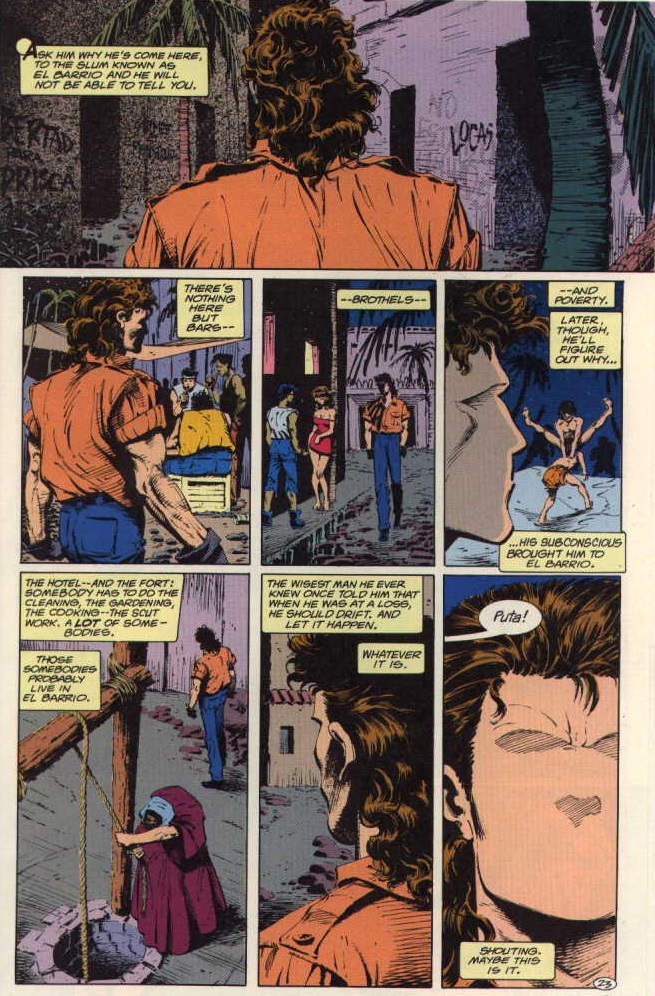 The Question #10
The Question #10
Colorists (in this case, Tatjana Wood) have played as large a part as artists in establishing Santa Prisca’s identity. After all, not only do they code some of the locals’ ethnicity through brown-ish skin hues, they also help project a heavy tropical heat that atmospherically engulfs the place and comes with its own set of connotations.
Social realism aside, the whole thing is proudly pulpy… The Question’s mentor, Aristotle Rodor, has been kidnapped and taken to another old fort built in the early sixteenth century – El Forteleza (yep, like Pena Duro, another awkwardly misspelled Spanish term, which I think helps give the place a perversely charming sense of crummy unreality). Hector Gomez, aka El Beato, a veteran of the war in El Salvador, meanwhile turned drug lord, bought the fort. In fact, he bought the government of the whole damn island (‘a bargain, by the way’) to insure non-interference as he established an ultra-high-tech drug lab.
A truly despicable character, El beato’s ultimate goal is actually to combine alchemy with quantum physics, using a billion-dollar particle accelerator in order to magically transform himself from a psychotic monster into a saint. The experiment results in a metaphysical explosion, but the Question still manages to save his buddy:

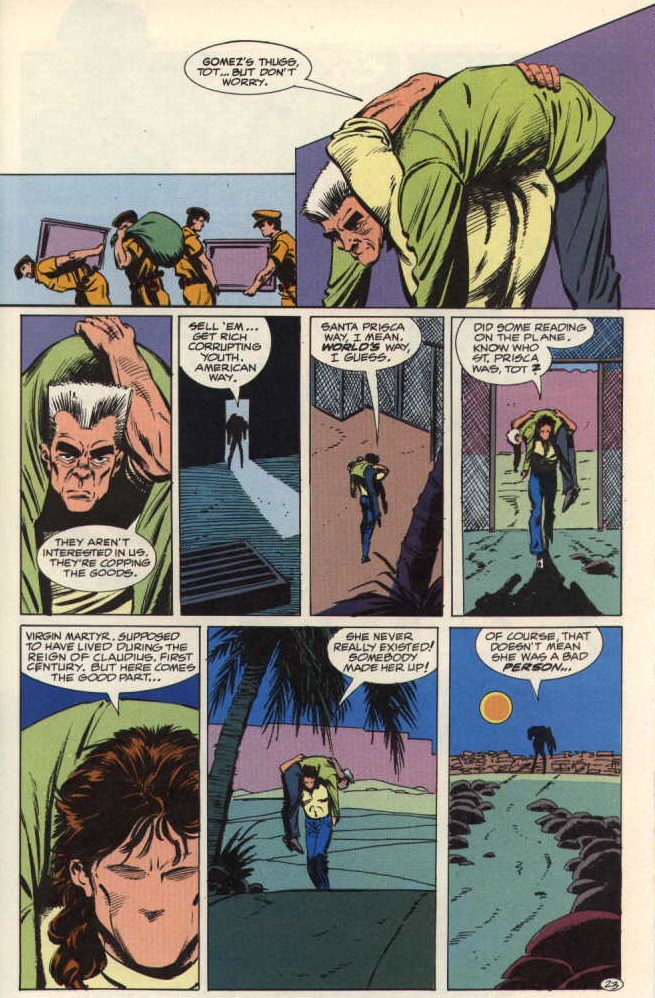 The Question #11
The Question #11
The end of the story implies that Hector Gomez’s spiritual epiphany brings some change to Santa Prisca, in the shape of liberal modernization. Elections are on the way and El Barrio is razed, with a North-American outfit hired to bulldoze the hovels and put up first-class housing in their place.
However, after the drug cartel breaks down, the island ends up being ruled by a loose coalition of thugs, including refugees from Cuba, Central America, the US, and the USSR (there is a police force, but it’s incredibly corrupt). At least that’s what we can see in a conceptual trio of 1989 annual issues: ‘Faces’ (Batman Annual #13), ‘Loosing Face’ (The Question Annual #2), and ‘Saving Face’ (Green Arrow Annual #2). (The leads in these series had already crossed paths in a neat trilogy of annuals the previous year.)
In the Batman story, written by James Owsley (later known as Christopher Priest), the Dark Knight hopes to clear out a man sentenced to the electric chair by taking Harvey Dent to the island, more specifically to El Monica, the infamous ‘world’s deadliest city,’ where several members of Two-Face’s mob have taken refuge. Curiously, we are given a notion that Bruce Wayne hasn’t forgotten about Santa Prisca and, in fact, has been involved in relief operations:
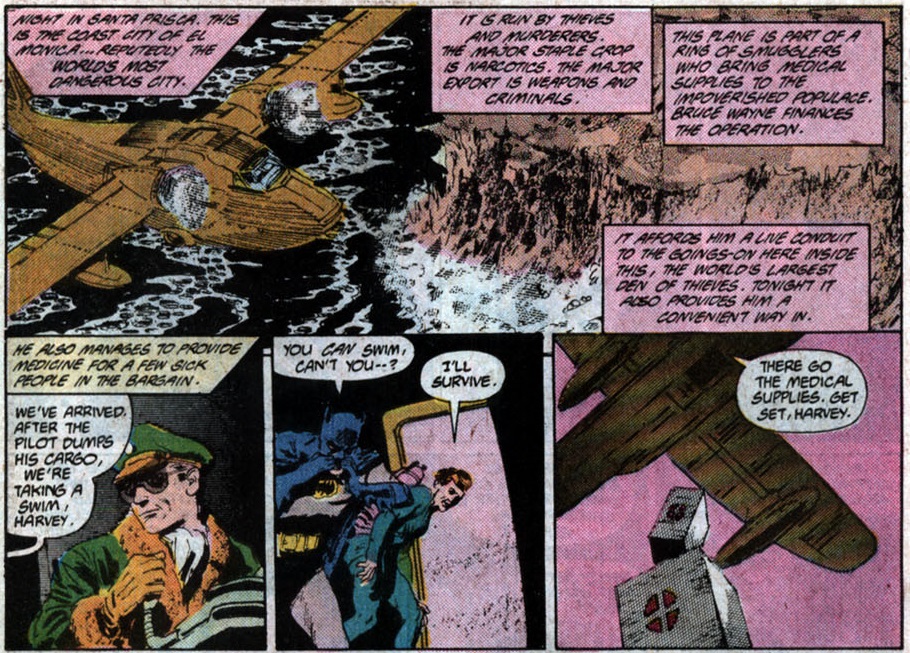 Batman Annual #13
Batman Annual #13
Bruce Wayne returns to Santa Prisca in 1993, looking for the kidnappers of Jack Drake (Robin’s father) and Doctor Shondra Kinsolving (Bruce’s physiotherapist/analyst/love interest). By then, the island is still riddled with drug dealers and terrorists, even though they no longer consider it a peaceful haven free from outside interference.
Bruce, who is confined to a wheelchair at the time (this is during the notorious Knightfall story arc), is joined by the Justice League Task Force, including Gypsy, Bronze Tiger, and Green Arrow. In order to safeguard his secret identity among all these people, in a brilliant mindfuck of a maneuver, he disguises himself as Bruce Wayne, leading the other heroes to assume he is somebody else underneath the obvious makeup! Sadly, this is the only amusing idea in an otherwise forgettable story (although it’s worth mentioning that Bronze Tiger does reluctantly beat up a dog, which is an oddly recurring motif in Denny O’Neil’s comics).
Arriving on the same airplane as Bruce is Selina Kyle, AKA Catwoman. She came to town in search of a hitman who tried to kill her but ends up becoming a local crimefighter for a while and actually saves the life of Santa Prisca’s ruthless leader, Juan Paolo Sebastion, better known as ‘El Jefe del País’ (and, possibly, Bane’s biological father). Anticipating the tone of the Narcos TV show, writer Jo Duffy uses Catwoman’s POV to describe a narco-state where the chief industries are ‘drugs, crime and human suffering.’

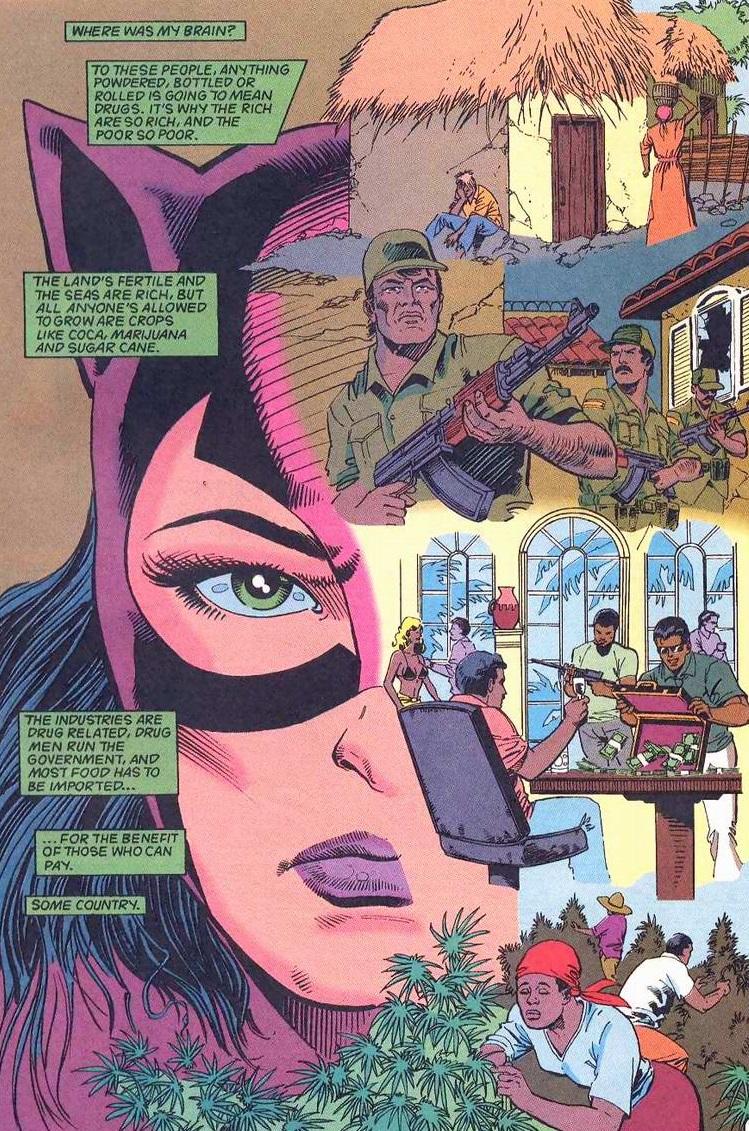 Catwoman (v2) #3
Catwoman (v2) #3
Fortunately, Batman comics aren’t always so grim. By 1997, the general and president for life of Santa Prisca has hilariously updated his title from Jefe del País to Jefe del Mundo!
Indeed, once again courtesy of Chuck Dixon, we get a more satirical look into the island’s corruption and poverty – and into North-American imperialism – in the awesome one-shot Birds of Prey: Revolution, where Santa Prisca’s dictator is ousted from power by a soda pop corporation after he dares nationalize the local agri-business of cola nuts.
The following year, in ‘Angel and the Bane’ (Azrael #36-39), we learn that there has been yet another revolution and two generals are now fighting for control of the island. Bane makes a deal to supply venom to one of them but he’s defeated by Azrael (in one of that series’ most solid adventure yarns).
In the early 21st century, we find Santa Prisca as a ‘rogue state’ where economic inroads are being brokered by the Zesti Cola Corporation. Here I’m referring to Scott Beatty’s soap operatic run in Gotham Knights, which picked up pretty much every loose end left by Dixon’s earlier work in Detective Comics, including one about Bane’s mysterious father…
If, in Catwoman #4, Jo Duffy had hinted that Bane’s dad was Santa Prisca’s latest dictator, Beatty explored juicer possibilities, starting with the prospect he was actually the son of Thomas Wayne, who was retroactively given a connection to Bane’s home country, harkening back to its Cold War past:
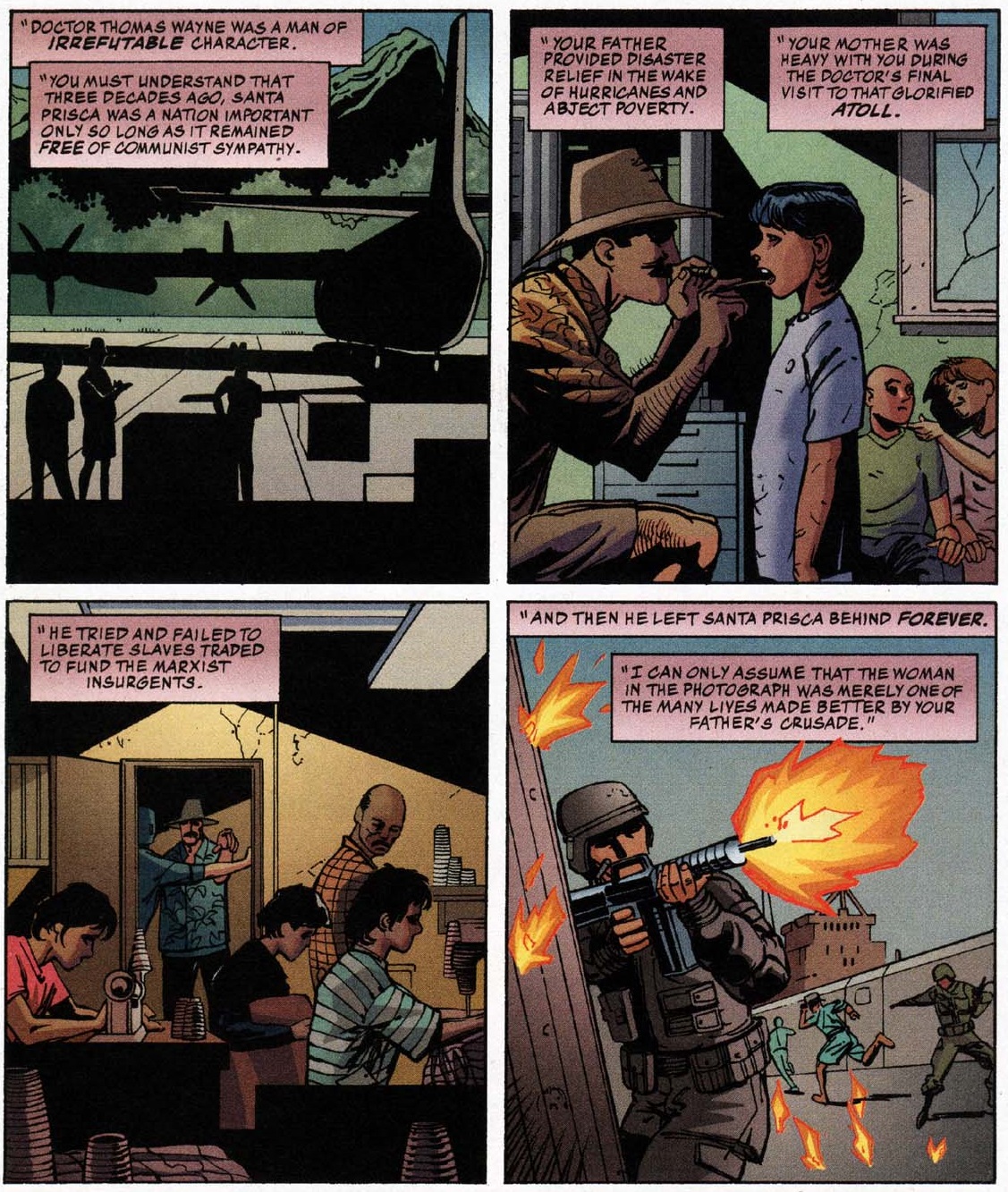 Gotham Knights #34
Gotham Knights #34
As you can tell by now, Santa Prisca is a place where white people go to suffer or to rescue others from suffering, like some sort of messianic saviors. Given the obvious racist and imperialist subtext, why do I love these comics so much?
Part of it, I admit, is the fannish knee-jerk response to world-building and continuity. It’s comforting to recognize elements from previous tales (especially tales I enjoyed), generating a sense of history and consistency in the wider DC meta-narrative.
But I also like all the weight the country carries as a repository of accumulated (foreign) imagination about the region – I find it fun to see multiple visions merge and collide as they play to different sensibilities, some more self-serious than others. Hell, as shown in the scan from The Question #11, the place’s hodgepodge identity is built into its very backstory: even the name is based on a lie.
And so, in the tradition of Batman comics, Santa Prisca isn’t just a poor country with a crime problem… It’s a super-poor country with a super-crime problem! In fact, the place has been increasingly incorporated into the DCU’s hyper-charged international politics: in the 2006 arc ‘The Hypothetical Woman,’ Gail Simone puts Santa Prisca in a sort of Axis of Evil coalition of countries who agree to supply their anti-superhero technology to a despotic exiled general in order for him to trash the Justice League of America. The joke is that Santa Prisca is clearly the biggest shithole in the bunch, so it ends up getting trashed by that very general when its government fails to meet an additional payment.
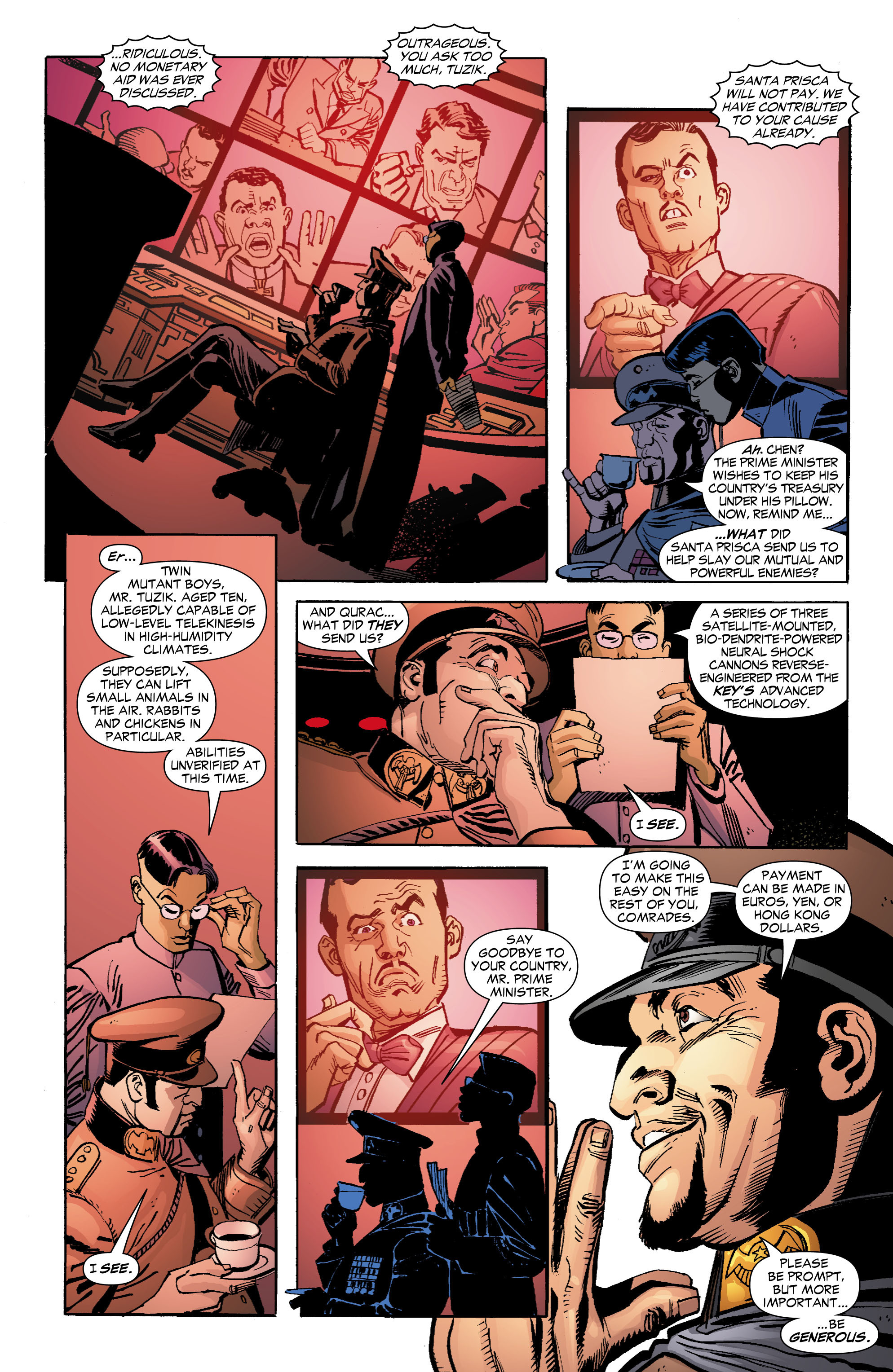 JLA Classified #17
JLA Classified #17
Under such conditions, perhaps it’s not surprising that Bane becomes a unifying national hero, despite – or because? – the fact that he continues to wear a luchador mask wherever he goes. In fairness, for a while he appears to have finally eliminated the drug cartels, so there’s that.
Bane even backs a popular anti-US coalition, but things quickly go bad when it turns out the elections have been rigged… However, because that story is told in the nifty super-spy series Checkmate, don’t assume Bane was the one behind the electoral fraud. Drawing inspiration from Operation Condor – and probably from more recent episodes like the failed 2002 coup in Venezuela – writer Greg Rucka instead has the US government (via Suicide Squad) trying to rig the elections *because* Bane’s candidate was the most likely to win.
That’s the last time I remember seeing Santa Prisca before the ‘New 52’ reboot. Since then, Bane took over the island, blew up the airports, and militarized the Peña Dura prison, turning the fortress into the new capital city (?). As a result, in recent times the few stories we got in Santa Prisca have just been set in the former prison, thus sacrificing the island’s visual and human diversity – the whole location has been narrowed down to a generic villain lair.
Which is not to say that the right artists cannot make it look it cool:
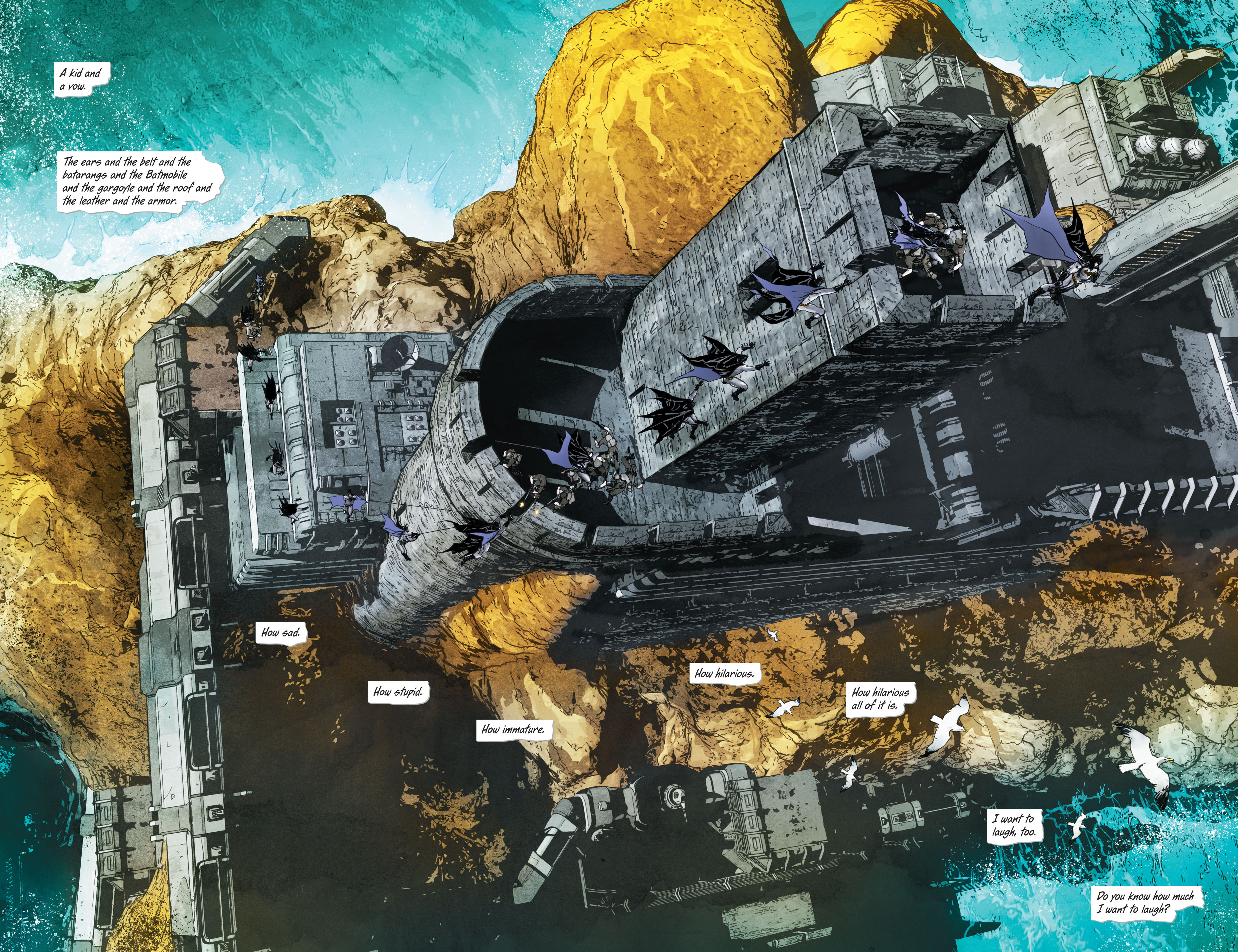 Batman (v3) #12
Batman (v3) #12
I get why this status quo would appeal to Tom King, who became the central writer in the franchise for the past years. Much of King’s work seems to be about processing his time as a counterterrorism operations officer for the CIA (a subtext pushed to a magnificent height in his excellent Strange Adventures), so there’s a blatant allegorical potential to reducing this foreign land to a dictatorship populated exclusively by evil bastards who occasionally attack the US and harbor its enemies.
In other words, it’s a place the heroes will sometimes have to invade, with or without outside permission…
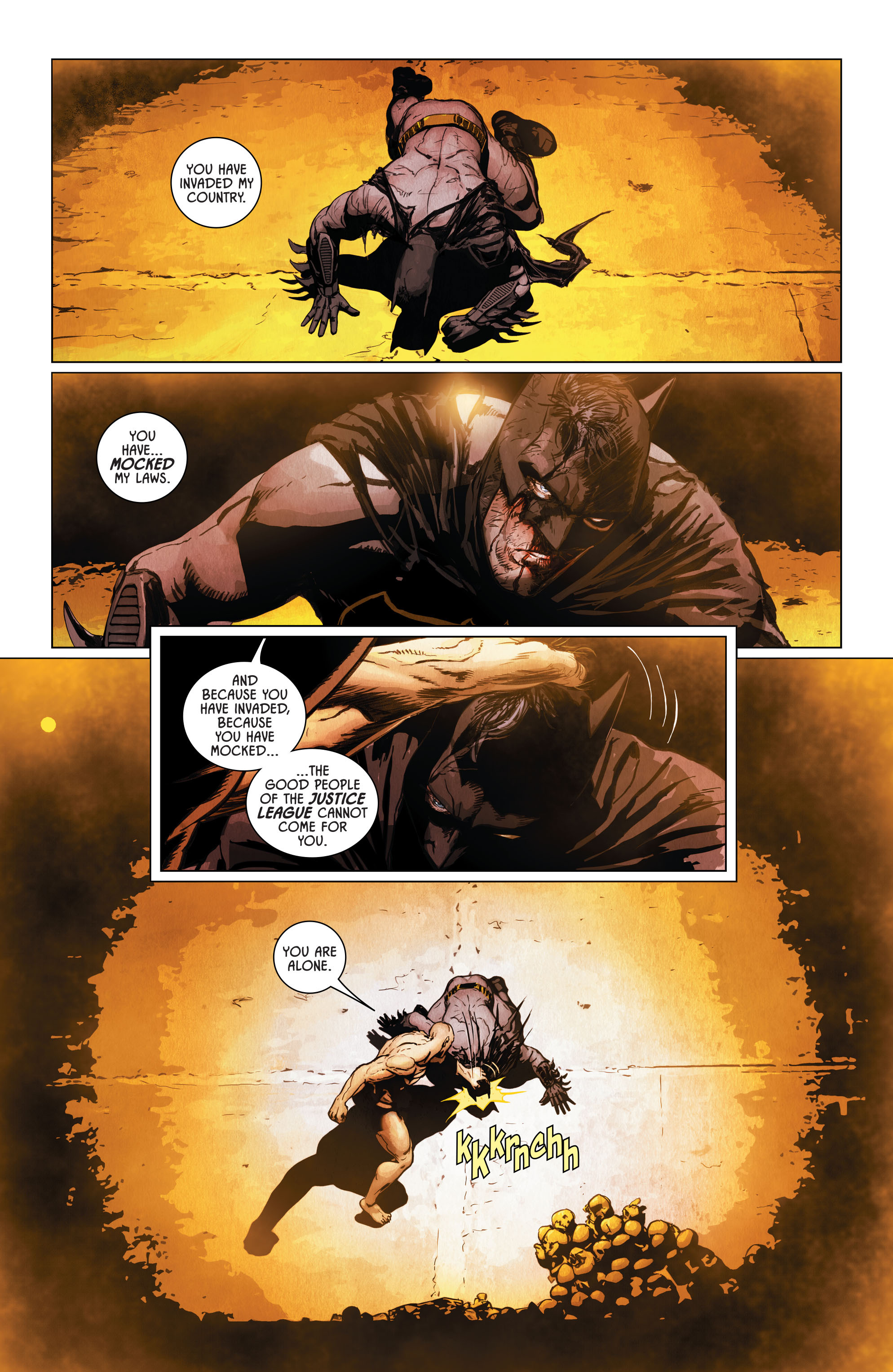 Batman (v3) #10
Batman (v3) #10
I find it kind of sad, really.
Even while providing a particularly exaggerated version of the nastiest clichés of Latin America, O’Neil, Duffy, and Dixon filled Santa Prisca with different types of people and displayed empathy – at least towards some of them. Yet all we get to see now is an army of offensive Latino criminals/soldiers/cannon fodder who blindly follow Bane.
That said, at least the location is still on the radar. And, for better worse, some writers seem interested in trying out different things, like when James Tynion IV briefly introduced another big player into the island:

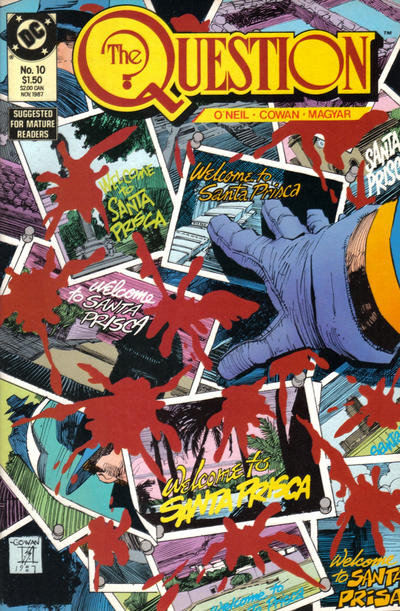
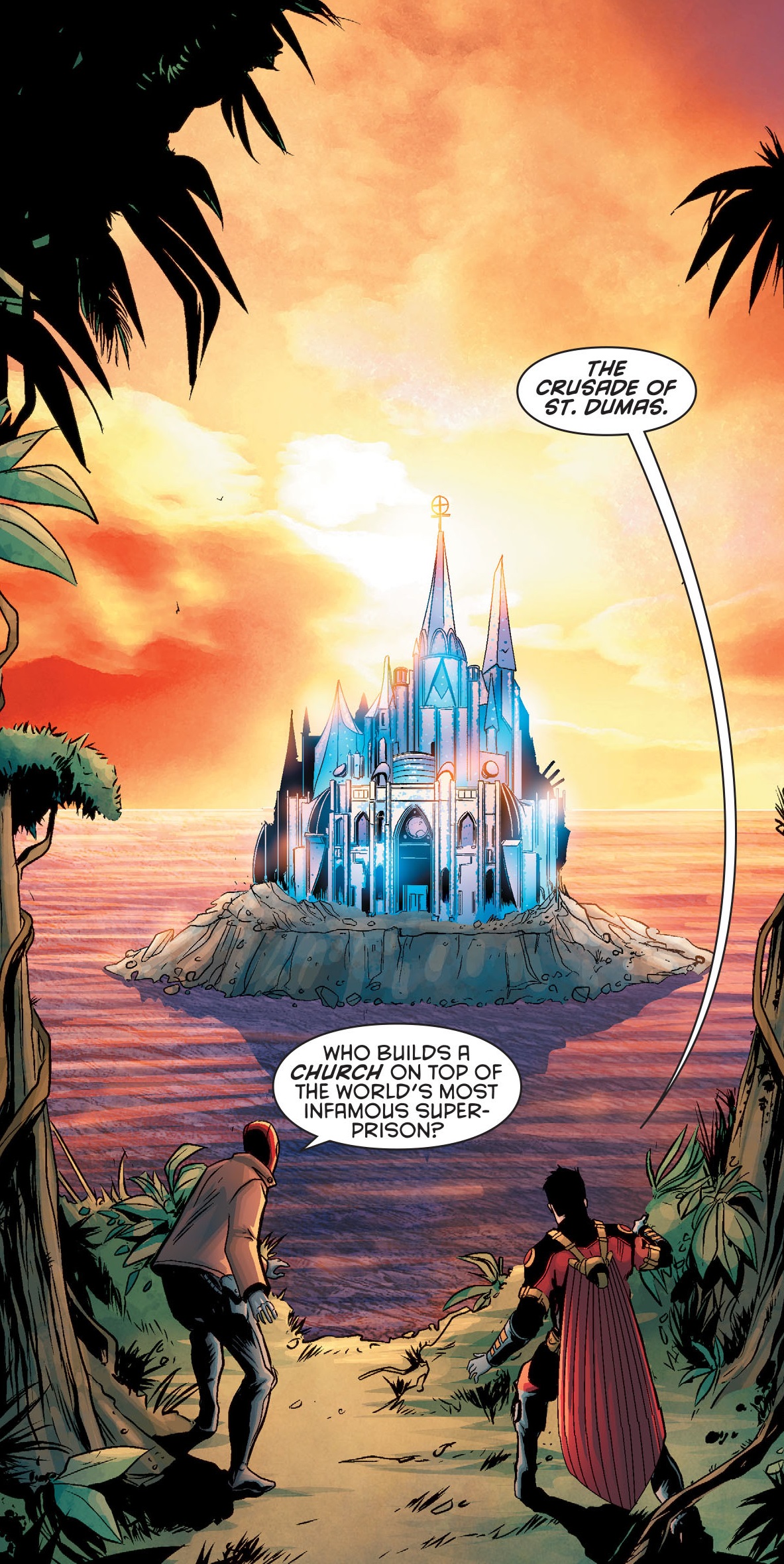
Tynion returned to Santa Prisca in his Joker maxiseries where the junta in control of Pena Duro cloned Bane to create Vengeance, his “daughter”. Just as eye-rolling as it sounds.